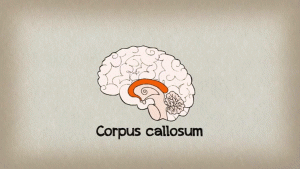Are those music lessons actually changing your brain’s structure and function?
Recent research says yes. This study focused on the symmetry of brain activity. We know that learning music has a big impact on our brain. Pinpointing how exactly it effects us is the next big thing.
We know that musicians are better at identifying pitch and speech sounds – Proof Here
We know that musicians brains grow differently than most – Proof Here
We also know that the corpus callosum (the strip of tissue that connects the left and right hemisphere of the brain) is larger in musicians – Proof Here
 Does this mean that that the two halves of a musician’s brain are better at communicating with each other compared with non-musicians?
Does this mean that that the two halves of a musician’s brain are better at communicating with each other compared with non-musicians?
Iballa Burunat at the University of Jyväskylä and her team decided to find out. Using an fMRI scanner, they peered into the brains of 18 musicians, and non musicians. The musicians were professional players with degrees in music. They were made up of various string, woodwind, and keyboard players.
Their brains were scanned all while listening to three different songs. Prog Rock, Tango, and Stravinsky was on the fMRI listening menu that day. The team measured their brains response to the music, and compared the brain’s left and right hemisphere’s activity.
Part of the corpus callosum connecting the two brain hemispheres was indeed larger in musicians. The team also found that musicians’ brains seemed to fire more symmetrically when they listened to music – the activity in the left and right hemispheres was a much closer match than that of the non-musicians.
The brains of keyboard players seemed to respond more symmetrically than those of musicians who played string instruments. Burunat thinks that this is because the playing the keyboard requires a more symmetrical use of your hands. Via New Scientist
Interesting…
“Keyboard players have a more mirrored use of both hands and fingers when playing,” says Burunat. “Although playing a string instrument also requires fine motor skills and hand coordination, it enforces a strict asynchrony between left-hand and right-hand finger movements.”
“It is surprising that the effect is instrument-specific,” says Marcus Pearce at Queen Mary, University of London. “It’s one thing to see differences in brain activity when they’re playing their instruments, but they’re just listening,” he says. “The perception of music is changed with musical training.” Via New Scientist
 Burunat thinks the musician’s brain might be better at communicating. But they have not yet tested how much of an impact it will have on other skills using two hands like typing. The team is also curious to know wether an ambidextrous individual would exhibit similar brain patterns.
Burunat thinks the musician’s brain might be better at communicating. But they have not yet tested how much of an impact it will have on other skills using two hands like typing. The team is also curious to know wether an ambidextrous individual would exhibit similar brain patterns.
The team think the two halves of a musician’s brain may be better at communicating than those of a non-musician. But they don’t know if this enhanced connection will give musicians an upper hand when it comes to other skills that involve using two hands, such as typing. Or even whether other people who use both hands almost equally would show similar brain patterns.
Why do some people get chills when they listen to their favourite music?
Even if you havent, youll know what I mean in a second. Triggered by your favourite songs, or types of music. Researchers at the Montreal Neurological Institute at McGill decided to tackle this question. Why do some people get chills when they listen to their favourite music?
5 Ways To Get The Most Out Of Your Child’s Piano Lessons!
Find the right Curriculum The right curriculum makes all of the difference. It is a long term strategy for your childs success in music. The definition of success varies from student to student. merriammusic.com

